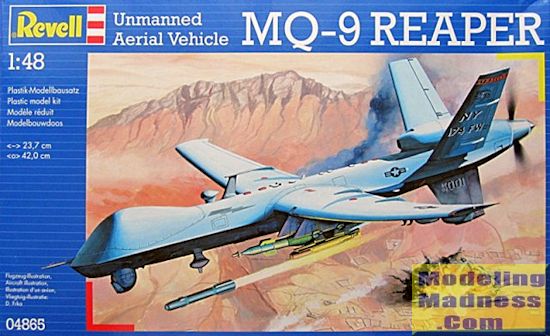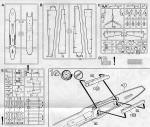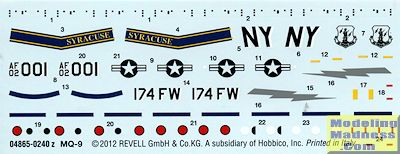
Revell AG 1/48 MQ-9 Reaper
| KIT #: | 04865 |
| PRICE: | $26.16 ($47.99 SRP) |
| DECALS: | One option |
| REVIEWER: | Scott Van Aken |
| NOTES: |

| HISTORY |
The General Atomics MQ-9 Reaper (formerly named Predator B) is an unmanned aerial vehicle (UAV) capable of remote controlled or autonomous flight operations, developed by General Atomics Aeronautical Systems (GA-ASI) primarily for the United States Air Force. UAVs are also commonly referred to as drones by the media. The MQ-9 and other UAVs are referred to as Remotely Piloted Vehicles/Aircraft (RPV/RPA) by the U.S. Air Force to indicate their human ground controllers. The MQ-9 is the first hunter-killer UAV designed for long-endurance, high-altitude surveillance.
The MQ-9 is a larger, heavier, and more capable aircraft than the earlier MQ-1 Predator; it can be controlled by the same ground systems used to control MQ-1s. The Reaper has a 950-shaft-horsepower (712 kW) turboprop engine, far more powerful than the Predator's 115 hp (86 kW) piston engine. The power increase allows the Reaper to carry 15 times more ordnance payload and cruise at almost three times the speed of the MQ-1. The aircraft is monitored and controlled by aircrew in the Ground Control Station (GCS), including weapons employment.
In 2008, the New York Air National Guard 174th Fighter Wing began the transition from F-16 piloted fighters to MQ-9 Reapers, becoming the first fighter squadron conversion to an all–unmanned combat air vehicle (UCAV) attack squadron. In March 2011, the U.S. Air Force was training more pilots for advanced unmanned aerial vehicles than for any other single weapons system. The Reaper is also used by the United States Navy, the CIA, U.S. Customs and Border Protection, NASA, and others.
It is probably not surprising that the USAF is having a great deal of difficulty finding pilots willing to spend years inside a trailer in Nevada. The number recruited has fallen far short of requirements, despite a $1500 a month bonus incentive. Most who enter flight training envision themselves soaring in Eagles and not sitting in the dark participating in glorified video games. Unfortunately, the USAF has locked the doors on many potential pilots by not recruiting enlisted personnel, many who have the skills needed and would be more than willing to fly these aircraft.
Then Chief of Staff of the United States Air Force General T. Michael Moseley said, "We've moved from using UAVs primarily in intelligence, surveillance, and reconnaissance roles before Operation Iraqi Freedom, to a true hunter-killer role with the Reaper." One only has to look as far as one's old Heavy Metal magazines to see that the future is now.
| THE KIT |
 This kit was released in 2012, but I had no interest in it until a recent Caracal decal sheet arrived and I was able to find one on Amazon for a really good price (free shipping, too as I also bought a blu-ray to meet minimums). It comes in a box much larger than it has to be for what is provided. The 77 pieces are molded in light grey plastic with a level of detail that is about average in the scheme of things. A bit crisper than old Airfix kits in this scale, but not as nice as Hasegawa/Tamiya. Probably due to the softer plastic.
This kit was released in 2012, but I had no interest in it until a recent Caracal decal sheet arrived and I was able to find one on Amazon for a really good price (free shipping, too as I also bought a blu-ray to meet minimums). It comes in a box much larger than it has to be for what is provided. The 77 pieces are molded in light grey plastic with a level of detail that is about average in the scheme of things. A bit crisper than old Airfix kits in this scale, but not as nice as Hasegawa/Tamiya. Probably due to the softer plastic.
One can dispense with all the cockpit stuff on a drone so that should speed up building as there is no angst about upgrading the cockpit with endless resin and photo etch bits. The long wings interlock with each other and need to be installed before the fuselage halves so they are trapped in place on hefty pegs. Clear wingtip formation lenses are provided. Speaking of hefty, 20 grams of weight is required to keep this puppy from tail sitting. Hence the possibly good idea of using SAC metal gear.
The stalky landing gear legs are nicely done and just as simple as the ones on the real plane. The only thing designed to move is the prop and that only because of the long prop shaft as there will be nothing to actually hold it in place once pushed on. The FLIR turret and wheels are to be cemented in place. The main wheels are two piece tires that trap the wheel hub while the nose wheel is molded in place.
Much of the kit in terms of parts is devoted to pylons and weapons. There are a pair of laser guided bombs and four Hellfire missiles to use as a weapons load. Now would think that perhaps the aircraft would need fuel tanks to carry more than a minimal load, but apparently that is not the case at all so fitting the model with laser guided bombs inboard and Hellfires outboard may well be appropriate.
 One set of markings is included, that being the 174 FW, New York ANG, an ex-F-16C unit from 2011. Revell provides only Revell paint references, making this company as irritating as Tamiya and Airfix in this regard and does not provide FS 595 colors. For the record, the aircraft are FS 36375 upper and FS 36176 on the underside. Note that the 174 Fighter Wing as on the decals is now the 174 Attack Wing.
One set of markings is included, that being the 174 FW, New York ANG, an ex-F-16C unit from 2011. Revell provides only Revell paint references, making this company as irritating as Tamiya and Airfix in this regard and does not provide FS 595 colors. For the record, the aircraft are FS 36375 upper and FS 36176 on the underside. Note that the 174 Fighter Wing as on the decals is now the 174 Attack Wing.
| CONCLUSIONS |
I am not sure how well drone kits sell, though the LHS has sold all it got it. One thing for sure, at any scale, one will need quite a bit of shelf space as there planes have quite long wings. The kit itself seems to be well engineered and could make for a relatively quick build. It will be something different from the usual Eagles, Phantoms and Mirages.
| REFERENCES |
http://en.wikipedia.org/wiki/General_Atomics_MQ-9_Reaper
March 2015 Thanks to your editor for the review kit. You can find this kit at your favorite hobby shop or on-line retailer. If you would like your product reviewed fairly and fairly quickly, please contactthe editor or see other details in the